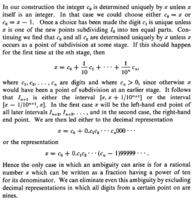In chapter 1, page 10, real numbers are found by confining them to an interval that shrinks to "zero" length. Basically, if [MATH]x[/MATH] is between [MATH]c[/MATH] and [MATH]c+1[/MATH], then we can divide that interval into ten subintervals, and we can, then, have [MATH]c+\frac{1}{10}c_1\leq x\leq c+\frac{1}{10}c_1+\frac{1}{10}[/MATH], where [MATH]c_1[/MATH] is a digit from zero to nine.
Repeating this process, and making [MATH]n\to\infty[/MATH] subdivisions, we'll eventually get [MATH]x=c+0.c_1c_2c_3...[/MATH]
I am confused by this, though:
1) How is he constructing that [MATH]I_{n+1}[/MATH] interval?
If I suppose [MATH]c_0-1\leq x[/MATH], then I can do [MATH]c_0-1+\frac{1}{10}c_1+...+\frac{1}{10^n}c_n\leq x[/MATH], and if I say that [MATH]n\to\infty[/MATH], then I can also write [MATH]\underbrace{(c_0-1+\frac{1}{10}c_1+...+\frac{1}{10^n}c_n)}_x-\frac{1}{10^{n+1}}\leq x[/MATH], so that [MATH]\frac{1}{10^{n+1}}[/MATH] is like an infinitesimal.
Would this be correct for [MATH]\left[x-\frac{1}{10^{n+1}},x\right][/MATH]? It should be the same with [MATH]x\leq c_0+1[/MATH] by subtracting [MATH]\frac{c_i}{10^i}[/MATH]s and adding [MATH]\frac{1}{10^{n+1}}[/MATH].
2) How is he getting the second representation with [MATH]c_n-1[/MATH]? (typo?)
I see that, maybe, we'd do [MATH]c_0\leq x[/MATH], and get it to [MATH]c_0+\frac{1}{10}c_1+...+\frac{1}{10^n}c_n\leq x[/MATH], but we would have [MATH]c_{i>0}=9[/MATH].
Thank you for your time.
Repeating this process, and making [MATH]n\to\infty[/MATH] subdivisions, we'll eventually get [MATH]x=c+0.c_1c_2c_3...[/MATH]
I am confused by this, though:
1) How is he constructing that [MATH]I_{n+1}[/MATH] interval?
If I suppose [MATH]c_0-1\leq x[/MATH], then I can do [MATH]c_0-1+\frac{1}{10}c_1+...+\frac{1}{10^n}c_n\leq x[/MATH], and if I say that [MATH]n\to\infty[/MATH], then I can also write [MATH]\underbrace{(c_0-1+\frac{1}{10}c_1+...+\frac{1}{10^n}c_n)}_x-\frac{1}{10^{n+1}}\leq x[/MATH], so that [MATH]\frac{1}{10^{n+1}}[/MATH] is like an infinitesimal.
Would this be correct for [MATH]\left[x-\frac{1}{10^{n+1}},x\right][/MATH]? It should be the same with [MATH]x\leq c_0+1[/MATH] by subtracting [MATH]\frac{c_i}{10^i}[/MATH]s and adding [MATH]\frac{1}{10^{n+1}}[/MATH].
2) How is he getting the second representation with [MATH]c_n-1[/MATH]? (typo?)
I see that, maybe, we'd do [MATH]c_0\leq x[/MATH], and get it to [MATH]c_0+\frac{1}{10}c_1+...+\frac{1}{10^n}c_n\leq x[/MATH], but we would have [MATH]c_{i>0}=9[/MATH].
Thank you for your time.

